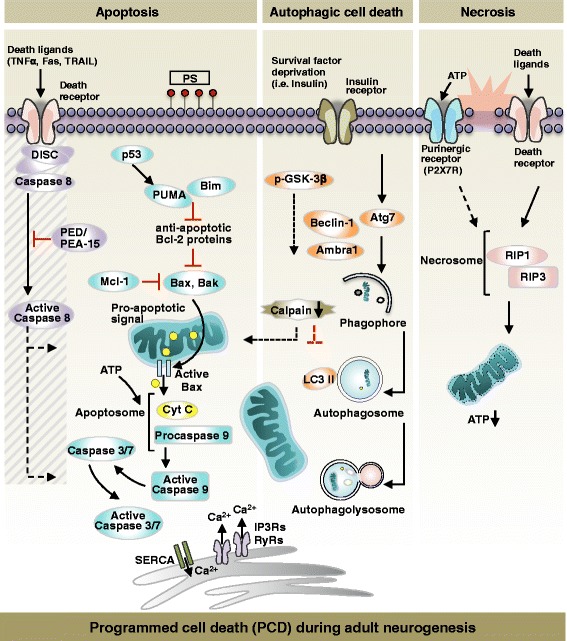Fig. 2.

The key players in the regulation of PCD during adult neurogenesis. Apoptosis: Pro-apoptotic signals induce Bax translocation to the outer membrane of mitochondria. Bax-mediated pore formation leads to the release of apoptogenic cytochrome c (Cyt c) into the cytosol and apoptosome formation. The apoptosome activates procaspase-9 and catalytically active caspase-9 induces activation of downstream effector caspases, caspase-3 and -7 (Caspase 3/7). Phosphatidylserine (PS) exposure at the cell surface is required for the clearance of apoptotic cells. In the adult neural stem cells (NSCs), p53, Bim and PUMA have been implicated in activating apoptosis. In addition, the pro-apoptotic proteins, Bax and Bak are the key regulators. Mcl-1 antagonizes the pro-apoptotic proteins, and therefore, considered as a critical anti-apoptotic protein for the survival of the NSCs. In extrinsic apoptosis, a death ligand (TNFα, Fas, or TRAIL) binding activates death receptor and induces DISC complex formation near the receptor. Upon DISC complex-mediated activation of caspase-8, intrinsic and extrinsic apoptosis converge at the level of the executioner caspase cascade. In adult NSCs, PED/PEA-15 represses the activation of caspase-8. Release of Ca2+ from the ER and subsequent transfer to the mitochondria promtes the commitment of NSCs to cell death. Autophagic cell death (ACD): Autophagy is induced when cells are starved of nutrients or survival factors. Atg7 regulates the maturation of autophagosome and initiates the lipidation of LC3 (also called LC3 II). Cargos subjected to degradation are degraded in the autophagolysosome. AMBRA1 and Beclin-1-induced autophagy is inversely correlated with apoptosis in adult NSCs. Under insulin-deprived condition, the adult hippocampal neural stem (HCN) cells succumb to ACD wherein the cell fate is under the control of GSK-3β activation. Inhibition of GSK-3β phosphorylation (p-GSK-3β) induces ACD. The negative regulator of ACD is calpain, which also mediates the crosstalk between apoptosis and ACD. Necrosis: Extracellular ATP or death receptor activation rapidly induces RIP1/RIP3 necrosome formation. Necrotic cell death results from the depletion of cytoplasmic ATP due to mitochondrial dysfunction. A purinergic P2X7 receptor-mediated necrosis induction has been reported in adult NSCs. However, regulator of necrosis in adult NSCs has not been identified to date
